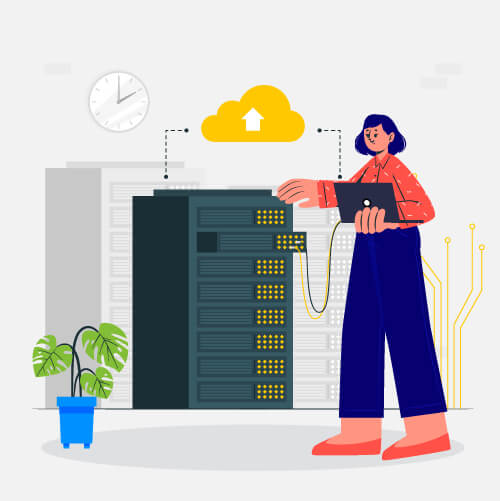Are Legacy Systems Holding Back Your Business Growth?
Business dynamics are changing at a pace that is several steps ahead of the software capabilities needed to keep up with them. However, to be operative in a world that is on the path of becoming digital-first, it is your business’s system and software which can aid or hold back your ability to grow and maintain its competitive edge.
Customers’ behavior is constantly changing and changing with them are business applications and use cases. An instantaneous, user-friendly, omnichannel and secure software has become the expectation of every modern-day customer looking to interact with a brand.
These changes require businesses to let go of or update their existing software, architecture, or application which keep them from meeting their business objectives and push them a step behind from attaining a competitive edge. Enter legacy software modernization.
Today, we are diving into some of the key questions that surround legacy enterprise systems modernization, including:
Table of Content
- What are Legacy Systems and Why Do Companies Still Use Them?
- What Are The Hidden Costs of Legacy Systems?
- What Are The Different Legacy Modernization Methods?
- Why Do Some Legacy System Modernization Processes Fail?
- How Can Appinventiv Aid Your Modernization Efforts?
What are Legacy Systems and Why Do Companies Still Use Them?
Let us start answering this two-part question by first looking into what is a legacy system and how to identify one.
Legacy systems is a concept that can be understood as an old piece of software, an incumbent technology, or a system that slows down the organization’s ability to expand, grow, or keep up with the changing market demands. When a system stops having a lack of IT support or stands unable to support the organizational needs, it can be called a legacy system.
Here’s how you can identify if you have a legacy system in place.
- It is no more supported by the vendors
- It doesn’t get any security updates
- It doesn’t integrate with the modern software
- You have to find workarounds for the processes
- You have to wait for it to load, finish, or simply run
- The maintenance cost is extremely high.
If there are so many issues with a legacy system, why do companies keep using them? Why are businesses still slow to the adoption of legacy system modernization approaches knowing it’s harming their brand? This brings us to the second part of the question.
Here are some of the most common concerns that we have heard in our enterprise software development services journey –
- “Our business processes have been custom-made. They have become fundamental and critical to our business performance.”
- “Updates are too risky, what if the key data gets corrupted or lost?”
- “Our software contains important business rules which are not mentioned in any document”.
- “It is impossible to find a new system that is functionally identical to the legacy systems”.
Even amidst these concerns, there are entrepreneurs who understand the need to migrate to new-gen softwares, especially to meet their digital transformation objectives.
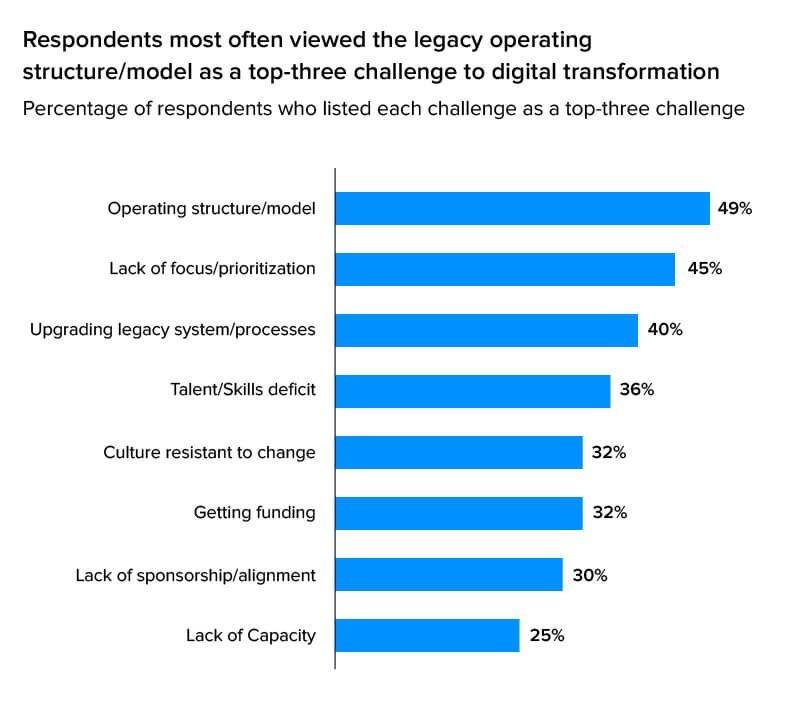
What Are The Hidden Costs of Legacy Systems?
Maintenance costs
Systems and applications become difficult to manage over time. Every other alteration adds up a level of complexity – these changes over a period of time introduce glitches. It takes very less time for even simple updates to become a time and money consuming task.
Support costs
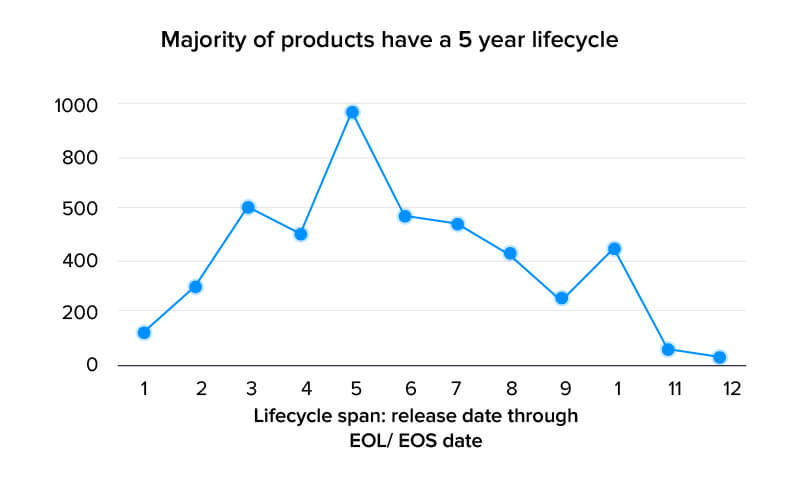
With the systems becoming old and outdated, the vendor support also lowers. So if you have been relying on third-party software providers, it will become all the more difficult to keep the software running if they stop providing the support altogether.
Legacy skillset costs
The upkeep of a legacy system calls for a legacy skillset. Once the employees carrying those skills retire, the talent pool shrinks. What makes it worse is that the market which has now moved to more new-gen technologies and systems curb the demand for legacy skills even further.
Agility costs
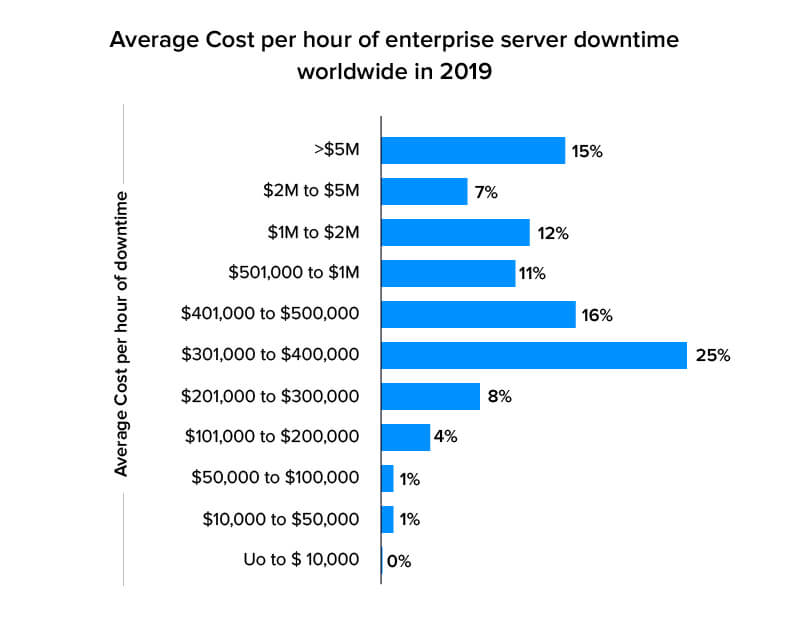
Most of the legacy systems are difficult to change. So what happens when you have to add in a new feature or application in the business? Here’s what – projects run longer and over budget. You keep encountering roadblocks during the project. Testing new features takes time since it is difficult to measure how well everything fits with the old system. These events tend to up the integration costs as well.
Up until this point, you must have gathered insights into why legacy system modernization services are necessary (in many ways a prerequisite) for any business looking to invest in enterprise app development.
We don’t want to get down to the reasons why IT legacy modernization is necessary, since they can be easily compressed into three reasons:
- High business operation cost
- Lack of ability to maintain a competitive edge
- Encountering challenges in digital transformation adoption
Besides these, Gartner estimates that every dollar put into innovating digital business through 2020 would call for enterprises spending at least three times that to modernize their legacy application portfolio.
While it is an expensive affair to update the legacy system, modernizing it also requires enterprises to spend a substantial amount of money. Getting the most out of your spent dollars requires you to carefully consider which software modernization strategy is good for you. “The key is to understand if your problem is caused by technology, architecture or functionality of the application, and how each modernization approach improves those aspects,” says Stefan van der Zijden, Gartner research director.
But how do you decide that?
- By ensuring that the legacy system is actually outdated and not for you anymore
- By having a complete understanding of how the different legacy modernization models work.
What Are The Different Legacy Modernization Methods?
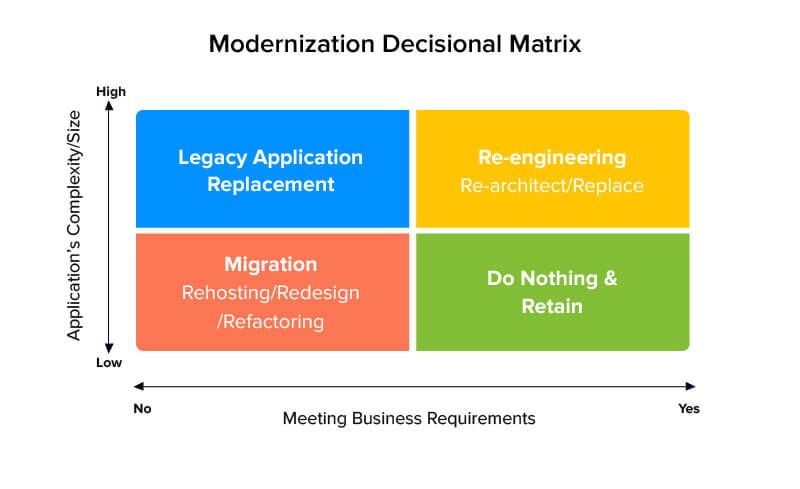
Legacy system modernization techniques, especially ones around older versions of applications, are difficult because they are custom-built in a single monolith style compared to a microservices model. This means that the software – data, network configurations, and security are all tightly coupled with the base infrastructure making it difficult to upgrade any one component.
Even small updates trigger slow, long regression-testing processes which involve the manual setup of a near-production test environment in addition to configurations, and appropriate data.
Here are the five ways legacy enterprise applications are generally handled –
1. Replatform
The approach involves the application of minimal changes in the legacy system and then moving them to another platform. Although it does not change the present system’s code function or structure, it allows you to host the applications on a less expensive platform. While re-engineering of projects take time the re-platform approach is fast and designed to keep underlying business logic intact. It means next to negligible impact on the operations of businesses.
The situations where the approach makes most business sense –
- There are very few functionalities which have to be modernized
- There is a business need to move some processes in the system on cloud
- There is a financial crunch in the company
2. Reface
This software modernization strategy surrounds scraping off some information from your legacy system and adding in a graphical interface. It helps with making your old software look new with some new UI features. The approach makes it unnecessary to procure any new technology, thus saving on the licensing cost.
The approach is best suited in case where –
- The management team has a strong association with the legacy application.
- IT teams are highly skilled in the old technology and know the ways to make continuous improvements.
- Although the software is old, the technology base is modern (e.g. J2EE/Java)
3. Rebuild
Here, you build the enterprise legacy system from the ground up. You can consult with your enterprise software development company on whether to rebuild the entire system or simply rebuild the core parts of the software portfolio. The approach, although extreme, offers the greatest returns and best competitive edge. Also, the technology stack is made to be competitive for several years in teh future.
The approach is chosen when –
- The present system is unable to support changes demanded by the market.
- The underlying technology is no longer supported by its vendor
- The present technology is very expensive to license
4. Extend and Migrate
This is one of the most well-strategized legacy software update methods. Here you gradually extend your legacy system and introduce new features and modern applications on a milestone basis. This way you get to perform legacy systems updates without replacing them altogether. It is one of the lowest-risk ways to transform the system by moving one component at a time. And since only one component is migrated, the cost of failure and business impact is very low.
The situations where it suits best –
- When you are looking to replace the entire system one element at a time.
- When there are only a few components which contribute to your current business process.
- When you have to change the current system from batch to real-time
- When there’s a need to modernize the outdated database with a RDMS system.
5. No System Change
In this approach, businesses adopt a wait and watch behaviour wherein they put modernization of systems on hold till a time when they’ll be able to find the best ROI of the process. This approach helps the company make decisions on the basis of industry changes and transformation.
The situations where the approach suits best –
- The company modernized in the past and has no immediate need to migrate
- The business is focused on absorbing the change in market or in their customers
- There is a lack of funding availability for modernization.
The five legacy modernization solutions are common among all the enterprise software modernization process. But however easy they sound in text, there are many challenges that their integration follows. Here are the difficulties that enterprise application development companies encounter.
Why Do Some Legacy System Modernization Processes Fail?
We just explored the risks associated with legacy systems and the different ways they can be overcome, although there are some key reasons which directly affect the results of their modernization process. Here are some of the common reasons why projects’ modernization fail –
Inefficient business processes
Before beginning a legacy modernization process, it is important to note what the problem is – is it caused by the legacy system or is the business process inefficient? Making new software while ignoring the ineffective business process can be a recipe for failure.
Making business adopt new software
Legacy system modernization brings a considerable change to your business. But the thing you have to note is whether the system is adapting your business or is your business adapting it.
For a successful modernization process, it is important that software should fit into the business process and needs and not the other way round.
For a software that asks your team to adopt a new process will meet with some dissatisfaction from your employees. Imagine working on a Word document and suddenly being asked to move the writing and editing process first on Google docs and then on a project management tool like Trello. While good for the business in hindsight, the suddenness is bound to baffle you – thus adopt a software that fits in your current processes seamlessly and has the ability to scale over time to help your employees get where you want them.
Modernizing all at the same time
There are a number of businesses that take modernization as a magic pill that will solve their digital transformation issues overnight. And under this misconception, they replace the legacy system right from its entirety with a new solution. The reality is that a complete replacement of the system forces disruption on not just employees but the customers as well, which is difficult for both classes of stakeholders to adjust with.
How Can Appinventiv Aid Your Modernization Efforts?
Whether you are looking to re-platform the legacy system or are looking to integrate a new solution in the system or simply want to re-architect the enterprise system, getting help from a skilled enterprise app development company is necessary for both short and long term outcome and success.
With extensive expertise in handling enterprise-level projects, our in-house software development team carries expertise in legacy modernization. Right from defining goals and establishing scope to integrating systems in your legacy software and working on a milestone-based migration, our team hand-holds you through the entire process.
Get in touch with us to design your business objective and understand the best route to migrating them into a digital-first software.

strategies your digital product..
